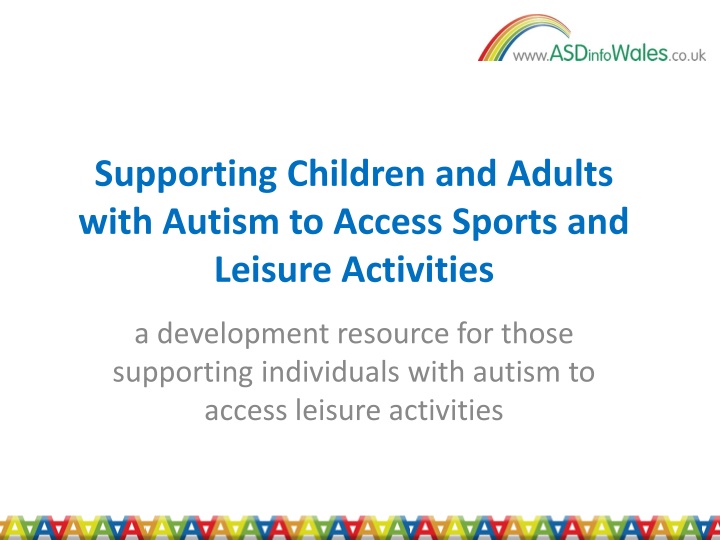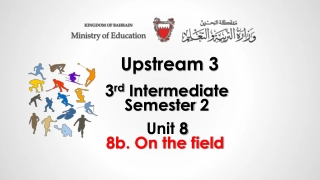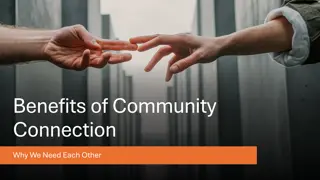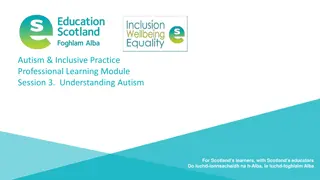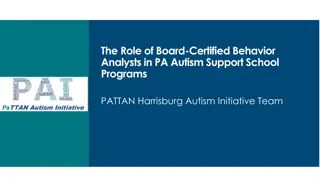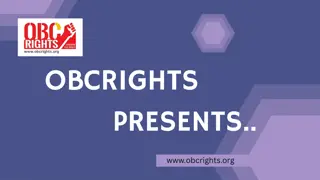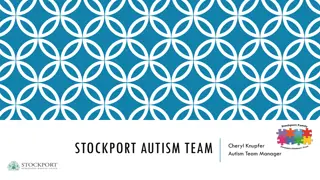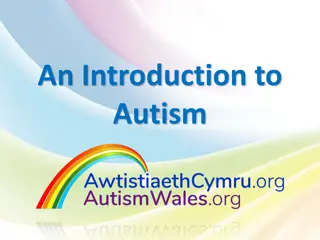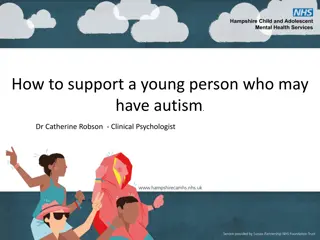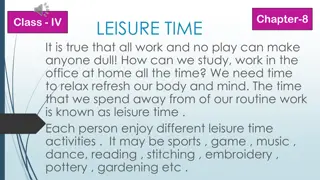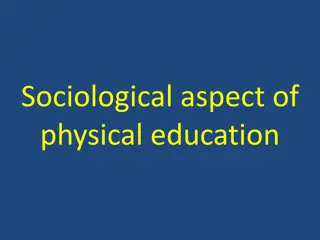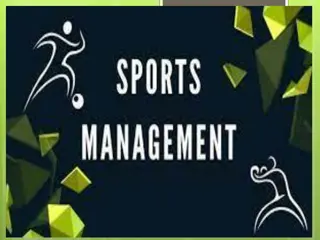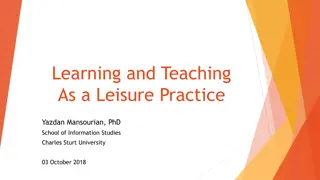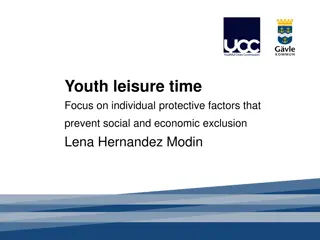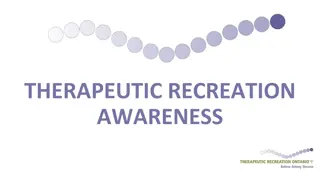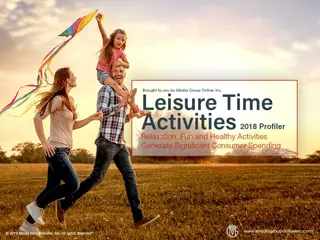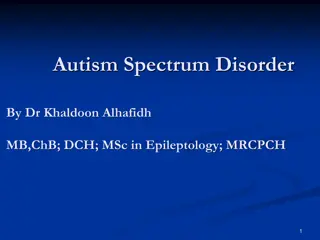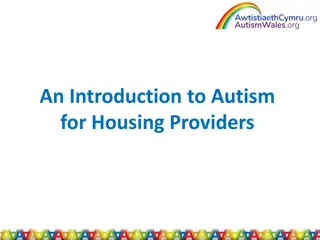Supporting Individuals with Autism in Accessing Sports and Leisure Activities
Understanding the challenges individuals with autism face in accessing sports and leisure activities is crucial for providing effective support. Autism, a hidden disability, affects social interaction, communication, and behavior. This resource aims to educate on autism spectrum disorders, highlight signs of autism, and provide strategies to accommodate and empower individuals with autism in participating in sports and leisure activities.
Download Presentation

Please find below an Image/Link to download the presentation.
The content on the website is provided AS IS for your information and personal use only. It may not be sold, licensed, or shared on other websites without obtaining consent from the author.If you encounter any issues during the download, it is possible that the publisher has removed the file from their server.
You are allowed to download the files provided on this website for personal or commercial use, subject to the condition that they are used lawfully. All files are the property of their respective owners.
The content on the website is provided AS IS for your information and personal use only. It may not be sold, licensed, or shared on other websites without obtaining consent from the author.
E N D
Presentation Transcript
Supporting Children and Adults with Autism to Access Sports and Leisure Activities a development resource for those supporting individuals with autism to access leisure activities
Autism is a hidden disability, meaning it is not easy to recognise when someone has the condition. When you see the following pattern (on a wristband, card or mobile device) it means someone has autism and wants you to know so that you can support them: Individuals with autism have difficulty in accessing sport and leisure activities. Support from staff can make a huge difference, understanding autism has the power to change lives. The information to follow is provided to help you to understand autism and ways in which you can support children and adults with the condition to access your provision.
Autism It is estimated that 1 in every 100 people in the UK have Autism Autism is a lifelong condition and affects people from all backgrounds Autism affects more males than females Many people with autism have not been diagnosed, and therefore may not realise they have the condition Individuals with autism experience difficulties with accessing sport and leisure activities
In this e-learning resource we use the word autism to encompass the spectrum of disorders including: Autism Spectrum Disorder (ASD) Asperger s Syndrome Autistic Spectrum Condition (ASC) Childhood Autism Pervasive Developmental Disorder
We refer to an Autism Spectrum because of the way in which the condition affects individuals can vary On one end of the spectrum people with autism may have an additional learning disability and be more severely impaired On the other end individuals may have an average or above average intellect and may function at a higher level
SIGNS of Autism Social Interaction and Verbal Communication are Impaired Imagination, ideas and creativity are reduced Gestures and non verbal communication are limited Narrow range of interests, routines and repetitive behaviours Sensory responses are unusual
Social Interaction and Verbal Communication are Impaired Individuals with an autism have impairments in social interaction and verbal communication. The way in which the person is affected varies. These impairments can include difficulties in : sharing understanding social niceties taking turns enjoying conversation using and understanding language showing concern for others
Social Interaction and Verbal Communication are Impaired Children with autism may find turn taking and sharing difficult. This can cause problems with friendships with other children. Children may find it difficult to instigate or join in play with other children. Children and adults with autism may find it difficult to show empathy, this can make them appear cold to others. Social rules may not be understood and additional support or advice may be needed with queuing, turn taking and team activities. People with autism may not enjoy conversation in the same way, and therefore prefer to discuss factual issues rather than enjoying the interaction with another. People with autism may interpret language literally and so may misunderstand idioms ( pull your socks up ) and metaphors ( my head was spinning ).
Social Interaction and Verbal Communication are Impaired Here are some ways that you can adapt your communication to help individuals with autism: Allow time for the individual to process information Speak slowly and clearly Don t use idioms or metaphors Avoid relying on gesture, facial expression or tone of voice Keep instructions short
Social Interaction and Verbal Communication are Impaired Here are some ways that you can adapt your communication to help individuals with autism: Initiate social interactions, if the individual needs help they may not feel confident enough to ask Explain rules rather than assuming they are understood Stick to facts and keep social chit chat to a minimum Provide additional instruction in relation to queuing, using changing rooms, payment etc Provide additional structure within activities involving turn taking or team activities
Social Interaction and Verbal Communication are Impaired Practice example 1 John, an adult with autism, wants to use the facility and is waiting in reception in order to pay. There is a long queue forming and John is stood to the side of the queue fidgeting whilst other customers in the queue are served. What could be the problem? How could you help John?
Social Interaction and Verbal Communication are Impaired John is fidgeting because he is becoming anxious as he does not understand the social rules and needs additional support or advice with activities such as turn taking, team activities and queuing. John wouldn t have felt confident enough to ask for help, you should always try to initiate any social interactions with individuals with autism. You could support John by showing him where to queue or open an additional till in order to serve John.
Imagination, ideas and creativity are reduced People with autism experience reduced imagination, ideas and creativity. Again, the extent varies from one individual to another. The impact of this can be affect many areas of daily life and may include difficulties in: predicting reactions and events problem solving relating to others creative activities planning coping with changes
Imagination, ideas and creativity are reduced How this impacts on day to day life: Playing team games often relies on social imagination to predict how other people will interact in the game. This can be difficult for people with autism. When problem solving, we rely on our social imagination to predict possible outcomes. This is difficult for someone with autism. Some people with autism have difficulties with creative imagination. Others have good creative imagination, and only the social imagination is affected. Often making free choices or generating creative ideas is difficult. Planning can be difficult without good social imagination, people with autism often rely on calendars or planners to help them with this. Coping with changes can be difficult without good social imagination. People with autism usually prefer routines to unpredictability.
Imagination, ideas and creativity are reduced Here are some ways that you help individuals with difficulties in social imagination: Use specific questions and limit using open questions Give a limited number of choices when giving options Break down instructions into smaller steps Provide options rather than relying on the individual to create an idea Support individuals with problem solving
Imagination, ideas and creativity are reduced Practice example 2 Sam, an adult with autism, wants to join the gym. A member of staff meets with Sam to understand what he wants to achieve at the gym, this involves asking lots of open questions such as What do you want to achieve from using the gym? and giving Sam lots of options to choose from. Sam becomes anxious when he is unable to answer and no longer wants join the gym. What could be the problem? How could you help Sam?
Imagination, ideas and creativity are reduced Individuals with autism, like Sam, have reduced imagination, ideas and creativity, this means they find problem solving difficult as we rely on our social imagination to predict possible outcomes. Planning or thinking ahead can also be difficult without a good social imagination which explains why Sam was unable to say what he wanted to achieve from joining the gym. Sam has difficulties in generating creative ideas or making free choices, to help someone with autism you should give a limited number of choices and provide options rather than making the individual develop their own ideas. Instead of asking open questions you should instead be specific with what you are asking them. For example, instead of What do you want to achieve from using the gym you could ask Do you want to improve your fitness?
Gestures and non verbal communication are limited This can include difficulties in using and understanding: facial expression body language tone of voice eye contact gestures
Gestures and non verbal communication are limited In order to understand when someone is being sarcastic, we analyse many non verbal cues. This means that people with autism may struggle to recognise and appreciate sarcasm. Avoiding eye contact maybe interpreted as the individual being rude, it is not. We often rely on tone of voice, as well as words to convey a point. People with autism may not be able to use or understand the meaning of this easily. Those with autism may find it difficult to interpret the meaning of your gestures for example pointing to indicate an object or direction. Someone with autism may not be able to use or may have limited use of gesture. Many individuals with autism find it difficult to concentrate on giving eye contact and listen at the same time.
Gestures and non verbal communication are limited Here are some ways that you help individuals with difficulties with gestures and non verbal communication: Do not rely on gesture or body language to communicate or emphasise a point Understand many individuals with autism do not like eye contact, they are not being rude Do not use gestures such as pointing in order to direct someone People with autism may find it difficult to imitate movements demonstrated to them Try to keep an even tone of voice
Gestures and non verbal communication are limited Practice example 3 Rachel, an adult with autism, asks for directions to the changing rooms from the reception area. A member of staff points in the direction of the changing room. Rachel does not move. The member of staff then gives a long explanation of directions to the changing room, Rachel still does not move. What could be the problem? What could be done differently to support Rachel?
Gestures and non verbal communication are limited Rachel finds it difficult to use and understand the meaning of gestures such as pointing to show direction, you should not rely on gestures to convey a point and instead say exactly what you mean. Instead of giving long lists of directions, the member of staff should have broken instructions down into smaller steps in order to make the information manageable for Rachel, writing instructions down could have also helped. Alternatively, the staff member could have taken Rachel to the changing rooms to avoid misunderstanding and difficulties in communication.
Narrow range of interests, routines and repetitive behaviours Individuals with an autism frequently have narrow range of interests, routines and repetitive behaviours. The way in which the person is affected varies. This can include: Repetitive movements such as hand flapping, spinning or finger flicking Insistence on repetitive behaviours or rituals Over focussed unusual or highly specific interests and hobbies Dislike of change, new people or activities
Narrow range of interests, routines and repetitive behaviours Here are some ways that you help individuals with : Explain changes in advance Use planners and timetables Engage in special interests Make allowances for repetitive movements Understand the need to complete rituals/routines
Narrow range of interests, routines and repetitive behaviours Practice example 4 Alice, a child with autism, usually enjoys her swimming lessons and attends every week. Her usual teacher is not available for this week and Alice is very distressed and is crying, kicking, screaming and refusing to participate in the lesson. What could be the problem? What could be done to help Alice if this was to happen again?
Narrow range of interests, routines and repetitive behaviours Individuals with autism dislike change, new people or activities. Alice was not expecting a different teacher and became anxious when someone unfamiliar was waiting to teach her. In order to reduce Alice s anxiety in the future you could prepare Alice by warning her of the change as far in advance as possible. You could try gradually introducing Alice to the covering teacher in advance so that she is able to become familiar with them. If the change was not known about, Alice should still be told about it as soon as possible and as far in advance as possible. Using picture planners and cards can also be used to help to explain changes.
Sensory responses are unusual Many people with an autism can have sensory issues. The individual with autism s perception of the senses can be heightened or decreased. All the senses can be affected. tactile (touch) (movement) vestibular proprioceptive (body position) visual (looking) auditory (hearing) (smell) olfactory gustatory (taste)
Sensory responses are unusual Sensory responses are unusual Here are some ways that you help individuals with unusual sensory responses: Be aware background noise can impact on their ability to focus on what you are saying Dim bright lights and turn down loud music Advise the individual of quieter times Move to a less stimulating area when giving instruction or direction Try to enable the individual to utilise sensory equipment during activities
Sensory responses are unusual Practice example 5 Tom, an autistic teenager, wants to join in a spin class but gets distressed when he sees how popular the class is and the room it is in and is not able to access the class. What could be the problem? What could you do to enable Tom to access exercise classes?
Sensory responses are unusual Tom is eager to join in the class but struggles to cope in busy, loud environments. Individuals with autism can have a heightened or decreased perception of the senses and can feel uncomfortable in busy and loud environments. To help Tom manage in a busy environment, like an exercise class, you could dim any bright lights and turn down loud music and where possible allow the use of sensory equipment such as ear defenders. You could also advise Tom on quieter times that he could attend.
How you can help: If struggling ask ask the individual, carers or seek advice from others Be understanding, people with autism can engage successfully in activities but may need support Consider how you can adapt the environment to decrease sensory issues Adapt your communication style Being aware of autism and the difficulties experienced by individuals with autism is key
There are numerous resources to help support individuals with autism on our website. www.ASDinfoWales.co.uk ASDinfo@WLGA.gov.uk @ASDinfoWales ASDinfoWales
